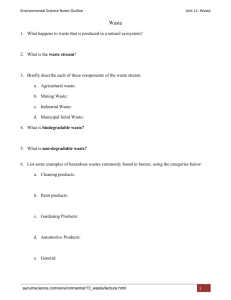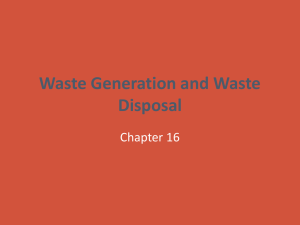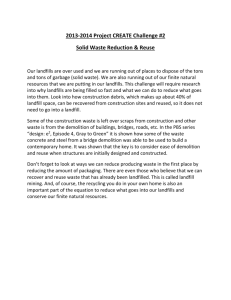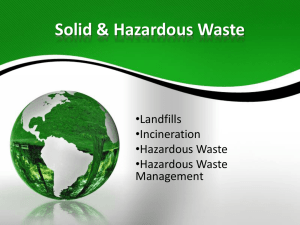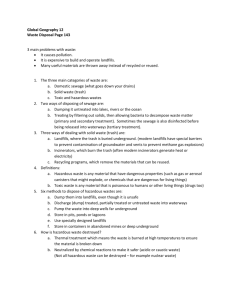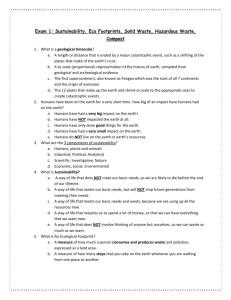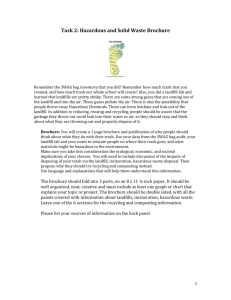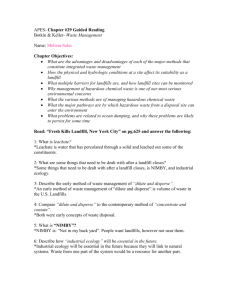Exam-1-Solid-Waste-and-Hazardous-Waste-Study
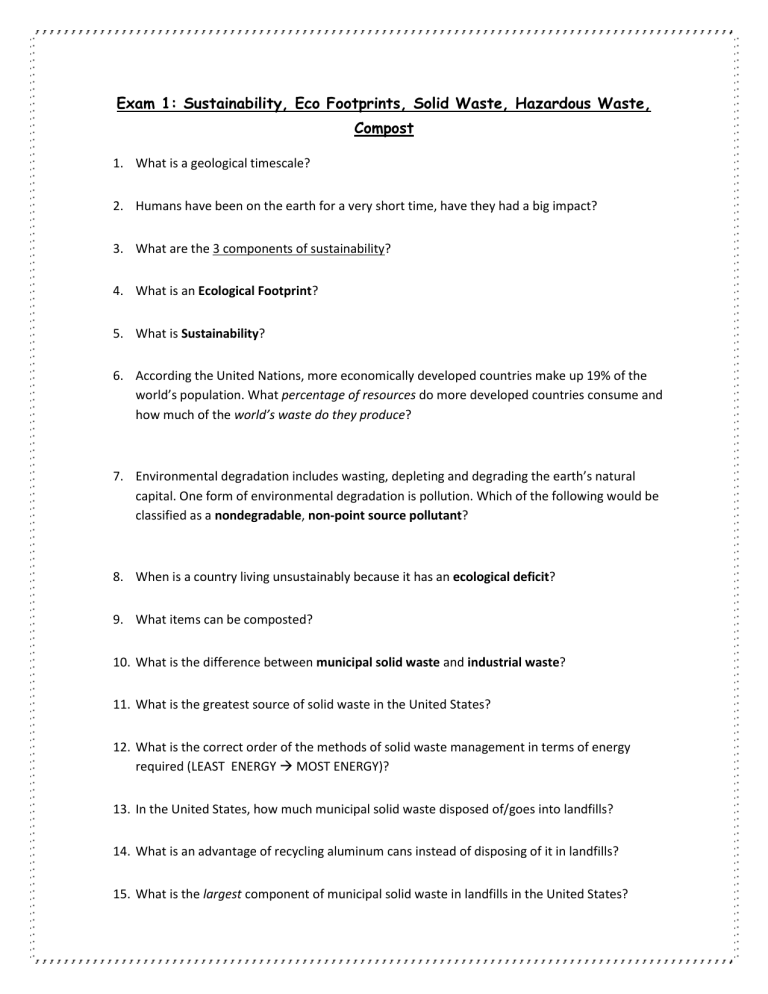
Exam 1: Sustainability, Eco Footprints, Solid Waste, Hazardous Waste,
Compost
1.
What is a geological timescale?
2.
Humans have been on the earth for a very short time, have they had a big impact?
3.
What are the 3 components of sustainability?
4.
What is an Ecological Footprint?
5.
What is Sustainability?
6.
According the United Nations, more economically developed countries make up 19% of the world’s population. What percentage of resources do more developed countries consume and how much of the world’s waste do they produce?
7.
Environmental degradation includes wasting, depleting and degrading the earth’s natural capital. One form of environmental degradation is pollution. Which of the following would be classified as a nondegradable, non-point source pollutant?
8.
When is a country living unsustainably because it has an ecological deficit?
9.
What items can be composted?
10.
What is the difference between municipal solid waste and industrial waste?
11.
What is the greatest source of solid waste in the United States?
12.
What is the correct order of the methods of solid waste management in terms of energy required (LEAST ENERGY MOST ENERGY)?
13.
In the United States, how much municipal solid waste disposed of/goes into landfills?
14.
What is an advantage of recycling aluminum cans instead of disposing of it in landfills?
15.
What is the largest component of municipal solid waste in landfills in the United States?
16.
What strategy to decrease the landfill volume of packaging material from food and other consumer products is the most energy efficient?
17.
What is an example of open loop recycling?
18.
What is an example of closed loop recycling?
19.
What are the parts of Integrated Waste Management?
20.
The International Basel Convention Law is often bypassed because E-waste disposal is often labeled as material to be recycled and sent across seas. Where is over 70% of the US’s electronic waste sent to?
21.
What is the most serious immediate problem associated with Sanitary Landfills?
22.
Which method of waste disposal reduces the volume of waste but could release toxic emissions
(air pollution) into the atmosphere?
23.
Which method of waste disposal is used most frequently in the United States today?
24.
Which method of waste disposal introduces microorganisms to break down hazardous organic compounds?
25.
Which method would be best suited for neutralizing the acidic components of waste?
26.
Which of the following is a disposal method for hazardous wastes that is generally viewed and/or historically viewed as being an acceptable management approach? (all that apply)
I.
II.
Deep well injection
Surface impoundments
III.
Above ground storage facilities
27.
Which of the following is a method currently being used to deal with/manage hazardous wastes in the United States? (all that apply)
I.
II.
Bioremediation
Phytoremediation
III.
Incineration with emission control technologies, such as an electrostatic precipitator that reduces air pollution coming out of smoke stacks
28.
What are the pros and cons of sanitary landfills?
29.
A waste is considered “hazardous” if it possesses one of four properties. What are those 4 properties?
30.
What is a drawback of phytoremediation?
Match the following compounds or elements with their descriptions.
(a) Methane (b) chlorine (c) dioxin (d) lead (e) leachate
31.
Produced when water infiltrates or percolates through waste material and becomes contaminated, and then leaks out of the landfill.
32.
Produced by the anaerobic decomposition of organic wastes in landfills; can be used commercially as an energy source, but is a greenhouse gas that affects climate change.
AP Environmental Science Free Response Question
Directions: Answer all of the questions, which are weighted equally; the suggested time is about 22 minutes for answering each question. Write your answers on the following page. Where calculations are required, clearly show how you arrived at your answer. Where explanations or discussion is required,
support your answers with relevant information and/or specific examples.
1.
The US is considered a “more developed” country and as a result is more efficient at managing their solid and hazardous waste. In 1984, The US Congress amended the Superfund Act to give citizens the right to know what toxic chemicals are being stored or released in their communities. This required 23,800 large manufacturing facilities to report their annual releases into the environment of nearly 650 toxic chemicals. Examples of chemicals that might be listed on the EPA website are Cadmium, Lead/TELs, Chlorine, PCBs, NO x
, SO x
and other VOC’s. a.
Cadmium leaks out of batteries in landfills. Answer the questions below about
Cadmium. i.
Describe one specific source, other than the local chemical plants, for the toxic pollutant you choose. Explain how the chemical would be get into the environment. ii.
Describe how the pollutant you choose enters the human body and one specific effect it can have on human health. iii.
Describe TWO specific steps, that a city or nation can take to reduce the threat of this pollutant. b.
Discuss TWO reasons why a multinational company would choose to build a manufacturing facility in a country such as India or China rather than the United States or Europe? c.
In some African and Middle Eastern countries, much of the economy is dependent on the fossil fuel industry of the nation. In addition, the wealth gained from the industry does not trickle down. For example, 90% of Nigeria’s exports are petroleum based products, while 70% of the nation lives in extreme poverty. Many US oil companies operate out of these countries. However, fossil fuel resources are running low. Describe what is meant by economic depletion of a resource and provide THREE economic, social or environmental effects of that depletion. d.
A sanitary landfill releases its findings that its deep well disposal drainage system is 80% effective at removing Cadmium leachate. It receives 200 mm/year of rainfall, and 50% of that is runoff. The landfill has an area of 10,000 m 2 . i.
Calculate the volume in m 3 that infiltrates the landfill per year. ii.
Calculate the volume of leachate in m 3 that is effectively treated by the deep well drainage system per year.



